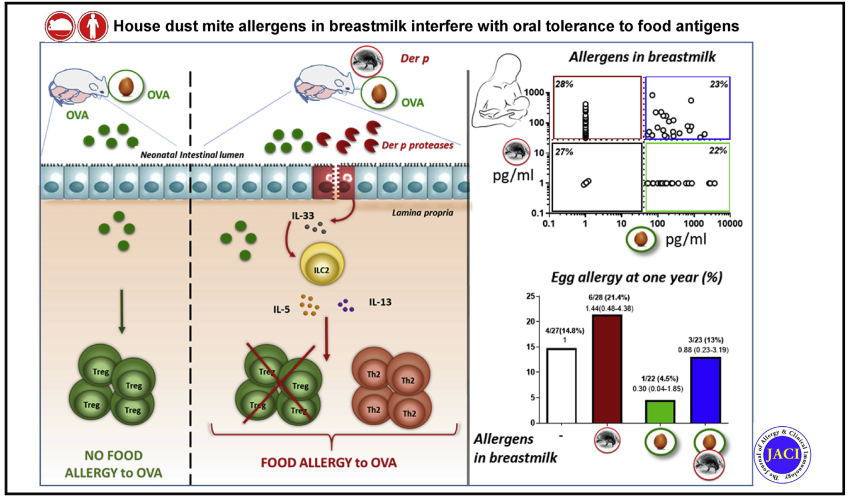Release date:2020-10-23

JACI
[IF:14.11]
A role for early oral exposure to house dust mite allergens through breast milk in IgE-mediated food allergy susceptibilityDOI: 10.1016/j.jaci.2019.12.912
Abstract:
Background: Successful prevention of food allergy requires the identification of the factors adversely affecting the capacity to develop oral tolerance to food antigen in early life.
Methods: Gut immunity was explored in 2-week-old mice breast-fed by mothers exposed to D pteronyssinus, protease-inactivated D pteronyssinus, or to PBS during lactation. We further analyzed oral tolerance to a bystander food allergen, ovalbumin (OVA). In a proof-of-concept study, Der p 1 and OVA levels were determined in 100 human breast milk samples and the association with prevalence of IgE-mediated egg allergy at 1 year was assessed.
Results: Increased permeability, IL-33 levels, type 2 innate lymphoid cell activation, and TH2 cell differentiation were found in gut mucosa of mice nursed by mothers exposed to D pteronyssinus compared with PBS. This pro-TH2 gut mucosal environment inhibited the induction of antigen-specific FoxP3 regulatory T cells and the prevention of food allergy by OVA exposure through breast milk. In contrast, protease-inactivated D pteronyssinus had no effect on offspring gut mucosal immunity. Based on the presence of Der p 1 and/or OVA in human breast milk, we identified groups of lactating mothers, which mirror the ones found in mice to be responsible for different egg allergy risk.
Conclusions: This study highlights an unpredicted potential risk factor for the development of food allergy, that is, D pteronyssinus allergens in breast milk, which disrupt gut immune homeostasis and prevents oral tolerance induction to bystander food antigen through their protease activity.
First Author:
Akila Rekima
Correspondence:
School of Molecular Sciences, University of Western Australia, M310, Perth WA 6009, Australia.
All Authors:
Akila Rekima, Chrystelle Bonnart, Patricia Macchiaverni, Jessica Metcalfe, Meri K. Tulic, Nicolas Halloin, Samah Rekima, Jon Genuneit, Samantha Zanelli, Samara Medeiros, Debra J. Palmer, Susan Prescott, Valerie Verhasselt
2020-09-14 Article
MK手机投注 | 安博·体育(中国)有限公司-官网 | 乐动官方网站 | 星空手机版 | 星空手机版 | mk体育(MKsports集团)股份公司 | 安博手机网页版登录入口 | 华体平台 | 千亿体育官网在线登录入口中国有限公司 |
 华亿体育(中国)游戏平台
华亿体育(中国)游戏平台
